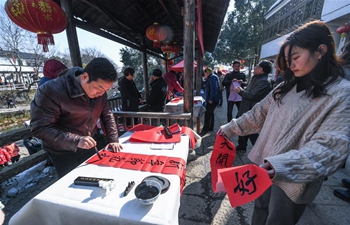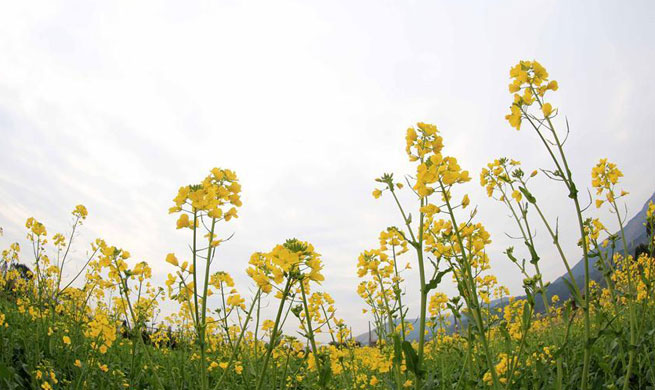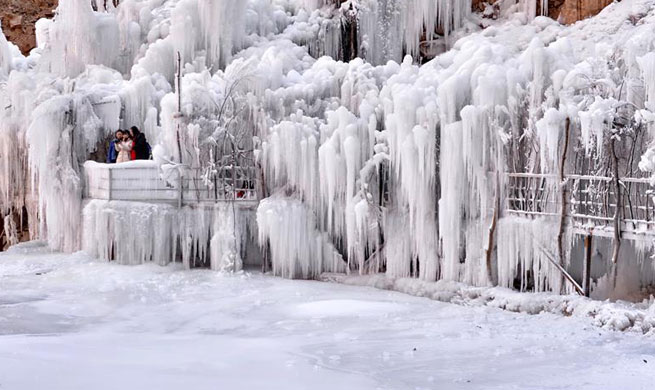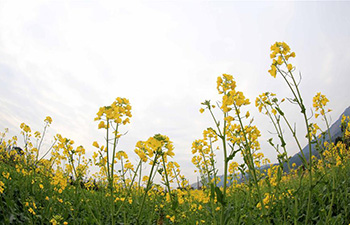by Shristi Kafle
JANAKPUR, Nepal, Feb. 4 (Xinhua) -- When Laxmi Devi Mahara arrived at the Dhanusa Dham municipality office after walking on foot from her village in Sarsarampur, she found herself seated among mainly women as most of the men from the village were either working in neighboring India or in Gulf countries.
Along with her fellow neighbors, she had to wait with her colorful identification card for around two hours for the formal program to begin. When her name called on the stage to receive the flood relief package, she couldn't hide her elation.
Dressed in red-patterned saree with her head covered as with the local tradition, Mahara's face shone after receiving two separate cartons containing non-food items like shawls, blankets, cooking utensils, an insecticide-treated bed net, a clean cooking stove, a water filter and hygiene kits.
Mahara is just one of the many recipients of relief packages distributed under the Chinese post-flood recovery assistance provided to Nepal's southern plain known as the Terai region, which was affected by one of the worst monsoon floods in history last August.
"My mud house collapsed after the flood and all the food items and furniture were damaged. We didn't get much support from our government and were facing a tough time. Amid such a crisis, getting this relief package is a miracle, I am very happy and thankful to China," Mahara told Xinhua in her native language Maithili.
A mother of four children, young Mahara doesn't even know her own age. Her home district Dhanusa, some 200 kilometers away from the capital city of Kathmandu, is often recognized for illiteracy and the tradition of early marriage.
Mahara is the sole breadwinner of her family. She works in fields with other villagers and is paid on a wage basis. Her husband is disabled and had to stay at home.
"Floods come every year, damage our settlement and we have to begin from zero. I wish we had a strong house," she said dejectedly, adding,"My small kids are going to be better in this winter however, with the warm blankets that I received today. I heard China provided them and I'm so grateful."
The relief packages that Mahara and scores of others received, come following China's 4 million U.S. dollars assistance to support the recovery efforts in the country's southern plains vulnerable to floods. The assistance has been provided under the framework of the China South-South Cooperation Assistance Fund.
Before that, the Chinese government provided 1 million U.S. dollars grant assistance to Nepal for disaster relief during the visit of Chinese Vice Premier Wang Yang in August last year.
The support has reached more than 31,800 households in seven districts spanning Sunsari, Saptari, Sarlahi, Dhanusha, Mahottari, Rautahat and Parsa located in Provinces 1 and 2.
A post-flood assessment conducted by the government of Nepal found that 1.7 million people were affected by the disaster.
The record rainfall resulted in widespread flooding across 35 districts and claimed the lives of 160 people. More than 40,000 houses were destroyed and 192,000 homes were partially destroyed. The disaster resulted in 21,000 families being displaced.
"As a close neighbor, China can feel the difficulties of Nepal and the Nepali people. I hope the relief packages could be a little help to the flood-affected families to overcome the tough time and with their recovery," Yu Hong, Chinese Ambassador to Nepal, told Xinhua after distributing the materials to locals in the Dhanusa and Mahottari districts.
The ambassador also visited some settlements which have already received the relief packages and learned about the living situation of local people, known as the ethnic Madhesi people.
The distribution program has covered 3,400 households in the Dhanusa district while 5,000 households in the Mahottari district await identification and verification by the newly-elected local government authorities.
The program has been in operation in close coordination with Nepal's Flood Reconstruction and Rehabilitation Project under the National Reconstruction Authority and implemented by UNDP Nepal.
Renauld Meyer, UNDP Country Director, told Xinhua, "After the visit, I found that the flood had caused a lot of damage and some of the villages have been completely wiped out. We are distributing the non-food relief packages to those hardest hit and the most underprivileged communities to restart their normal lives."
Expressing gratitude to the Chinese government for its generous support and partnership with UNDP, Meyer said that it's not just about the relief packages, but the visit of the ambassador herself to the affected community in a remote village signifies Chinese solidarity.
"I hope the disasters are not only responded to but be prevented. We hope to come up with longer term interventions regarding disaster preparedness," he told Xinhua after the distribution of aid in the Loharpatti municipality of the Mahottari district.
Nepal's Terai region is not only vulnerable to disasters like floods, but also struggles in terms of health and education in which poverty stands as the major cause.
According to a report by the Demographic and Health Survey released in November last year, Province 2 is poor in regard to nutrition, teenage pregnancies, family planning, newborn deaths, vaccinations and domestic violence against women, among others.
Ram Chandra Mandal, leader of Province 2, told Xinhua, "Despite the historical significance and rich natural resources, it is unfortunate that our region is dominated by poverty. I hope the Chinese government will continue to help develop this area."
















